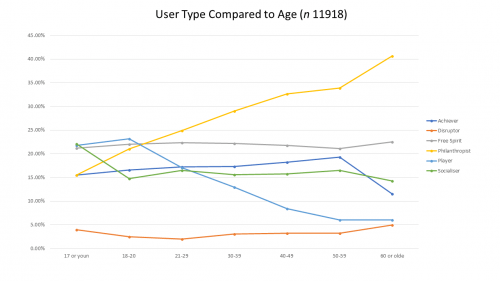When speaking to people about gamification, I often hear comments along the line of “Yeah, but games are only for kids”, or “Yeah, but the age groups who work here are not interested in games”.
What is very nice these days, is how easy it is to dispell these myths with statistics (yeah I know, Lies, Damned Lies and Statistics).
Roughly (I say this as this is coming from multiple sources and 2017 quarters), in the UK, 43% of people aged 6-64 say that they play video games in some form. Of that group, 57% are male, 43% female. If we consider that working age is around 18 to 60 (ish), you are looking at about 78% of the total gaming group are potentially playing games., peaking around the 25 to 44 age group, but still significant in the 44 to 64 age group.
That means that if 43% of the population is playing games, and 78% of that is in the workforce that shows that at least 30% of your workforce are officially gamers – across all age groups. That may not seem a huge number but think of that as 30% who are easy to engage with good gamification.
There is still 70% left. Now, if you read my blog the other day about the 70/30 rule, you will know that we can assume that around 30% of people will find a reason not to engage, no matter what you do! So actually that leaves us with 40% left to engage in some way.
That is where understanding the population of your employees and their motivations is so important. User Types can help a little here, but not in the way I normally speak about them.
Age Does Make A Difference
Sure, knowing the general motivation of your users is great, but actually, there is something else we can learn from the user types. How age affects your motivations. The most recent analysis of my survey shows some very obvious differences around age groups (remember that age is not as big a determining factor on who plays games as you may think).
Whilst Relatedness, Disruption, Mastery (mostly) and Autonomy stay stable across age groups, Altruism (Purpose) and the desire for Rewards seem to change dramatically!
There are probably many factors that affect this, but it is safe to say that when designing systems, you need to consider that the older users will be far less interested in the shiny things over time, and much more interested in ways to give back to the system.
How do you do that?
Well, one of the things I find my self doing more and more is wanting to teach others, to share my knowledge in some way. That may be simple in a learning platform, by giving people mentor roles, but in something like an onboarding platform – where everyone ins new – that may seem much harder!
However, you can learn by teaching. I have started to teach guitar recently, but I am not the most knowledgeable on the theory side. So, I am onboarding myself into the theory by learning it in a way that allows me to effectively teach it to others. It is very focusing to know that you need to understand something well enough to be able to explain it to others in a way they can understand – and that is actually correct! It is like learning by doing on steroids!
No Excuses
By creating gamified systems that are non-patronising, don’t rely entirely on being gamey and gimmicky and by understanding the differences between people, their interests, motivations, ages, genders etc, you can cover that 40% that are “tougher” to engage with game-based solutions. But what you can’t do is say that “XXX don’t play games”, because it is a fairly high probability that they do. Just ask my 79 year old Dad when he is playing his nightly game of Call of Duty!!
Similar Posts:
- Why am I interested in Gamification?
- New Gamification User Type Test
- Quick Gamification Advice: The 70/30 Rule
Also published on Medium.


